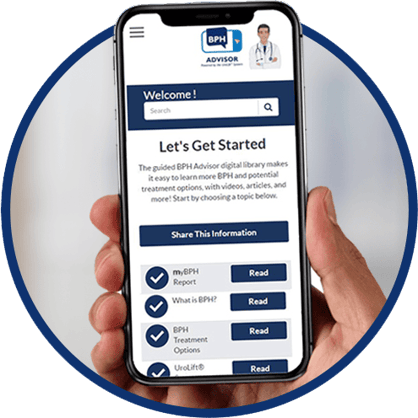
Enlarged Prostate Treatment Options
Struggling with BPH symptoms (benign prostatic hyperplasia)? Knowing about common BPH treatments can help when talking with your doctor about your concerns.
What are my options?
If you have BPH symptoms that are just not improving, or are getting worse over time, it's important to talk with your urologist. Click the boxes below to learn about common treatment options.
Medications
These include alpha blockers, which relax bladder neck muscles, and 5-alpha reductase inhibitors which act to shrink the prostate.
UroLift™ System
Small implants are placed to lift or hold excess tissue out of the way so it no longer blocks the urethra – with no heating, cutting, or removal, of prostate tissue.3,4
Thermotherapies
Heat, such as steam or hot water, is applied directly to the prostate to destroy excess tissue.
Laser
Concentrated light is used to generate precise, intense heat to destroy excess prostate tissue.
Waterjet Ablation
A high-velocity waterjet is used to destroy excess prostate tissue, using an image-guided robotic arm.
Transurethral Resection (TURP)
An electric wire loop or laser fiber is used to remove or vaporize excess prostate tissue.
How BPH Treatment Options Stack Up
The treatment plan you and doctor decide on will likely be influenced by many factors, including quality of life, importance of certain activities, potential side effects, and level of risk involved.
See how typical BPH treatment options align with common treatment goals. Which goals are most important to you?
Don't Hesitate to Ask Your Doctor
Many people aren’t comfortable talking about sensitive health topics, even with their doctor, and may downplay or avoid discussing their worsening urinary issues. Health care professionals, especially urologists, often talk with people about urinary problems, and the good news is, BPH symptoms are generally treatable. Discussing your health concerns is the first step towards finding solutions.
Don't hesitate to ask your doctor about minimally invasive procedures like the UroLift™ System.
You May Need to Ask
Let your doctor know if BPH medications aren't helping enough or if you have concerns about potential side effects. Ask about minimally invasive treatment options that align with your treatment goals.
75%
Surveyed said they weren't informed about minimally invasive procedures as an alternative to BPH medications*
Take Care of #1
Part of the standard of care,6 the UroLift™ System can be used to treat a broad spectrum of anatomies, including lateral and obstructive median lobe and prostates up to 100cc.4,5
#1
The UroLift™ System is the #1 chosen minimally invasive BPH procedure in the U.S.**
Don't Let BPH Hurt Your Sex Life
Patients treated with the UroLift™ System achieved better reported outcomes in sexual function§ and satisfaction than men who received BPH medication.3
57%
Of men surveyed believe that BPH affects their relationships and 61% say it impacts sex*
Questions to Ask
As you weigh treatment options with your doctor, make sure to ask about typical patient experience and outcomes. This includes, but is not limited to:
For procedures
- How fast will I experience BPH symptom relief?
- What level of symptom relief can I expect?
- What are the common side effects?
- What are the anesthesia options; is a hospital stay required?
- Would I go home with a catheter?
- When can I return to normal activity?
For medications
- What level of symptom relief can I expect?
- What side effects are typical and are any serious?
- Will I always need to be on BPH medications and are they known to be effective over time?
- Will delaying having a procedure increase my risk of bladder or kidney disease?
- If medications aren't helping enough, what are my options?
"The advice I would give to men who experience BPH is not to sit around and think it's going to go away...go get yourself checked out." ‡
- Corey B, Age 52
Mike and His Doctor Discuss BPH Symptoms and Treatment Options
The UroLift™ System - Mike Asks What to Expect
Learn About Diagnostic Evaluations for BPH
Learn About Common BPH Medications

Sign up for BPH Advisor™
Join this free, personalized patient education program, and get your customized myBPH Report™.
How UroLift™ Works
Learn more about this minimally invasive approach to treating BPH.
Find a Physician
Search for UroLift-trained physicians in your area.
Insurance Info
The UroLift™ procedure is covered by Medicare, national, and commercial plans.*
*when medical criteria are met
Read the BPH Blog
Check out these helpful articles on BPH and related topics.
References
1. Roehrborn, J Urology 2013
2. AUA Guidelines 2003, 2020
3. Roehrborn, Eur Urol Focus 2021
4. Rukstalis, Prostate Cancer Prostatic Dis 2018
4. UroLift System Instructions for Use
5. AUA BPH Guidelines, 2021
† As with any medical procedure, individual results may vary. See patient safety for more information.
*Survey of US men aged 40+ who have been diagnosed with BPH (enlarged prostate) and are/have been treated with BPH medications, conducted by Teleflex in 2020. Data on file, n=96.
**U.S. 2022 estimates based on US Market Model 2022-24 (5-17-22 FINAL), which is in part based on Symphony Health PatientSource® 2018-21, as is and with no representations / warranties, including accuracy or completeness.
§ Based on an indirect comparison of erectile and ejaculatory function and sexual satisfaction in men who received PUL in controlled studies or in men who received medical therapy in the MTOPS study.
MAC11000-02 Rev A
